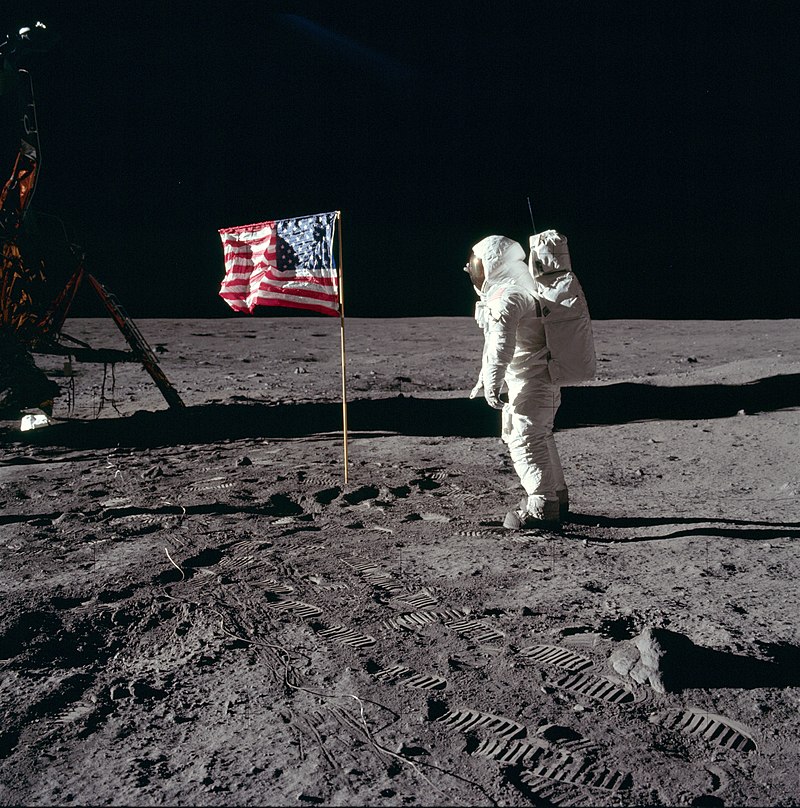
THE APOLLO 11 MOON LANDING
The 50th Anniversary of
the Apollo 11 Moon Landing
is Saturday, July 20, 2019
Apollo 11 was the spaceflight that landed the first two people on the Moon. Commander Neil Armstrong and lunar module pilot Buzz Aldrin, both American, landed the Apollo Lunar Module Eagle on July 20, 1969, at 3:17 PM CST. Armstrong became the first person to step onto the lunar surface six hours later on July 21 at 9:56 PM CST Aldrin joined

him 19 minutes later at 10:15 PM CST.
They spent about two and a quarter hours together outside the spacecraft, and
collected 47.5 pounds of lunar material to bring back to Earth.
Command module pilot Michael Collins flew the command module Columbia alone in lunar orbit while they were on the Moon’s surface.
Armstrong and Aldrin spent 21.5 hours on the lunar surface before rejoining Columbia in lunar orbit.
A new website transports you back in time to 50 years ago, when Neil Armstrong, Buzz Aldrin and Michael Collins first shot for the Moon.
Apolloinrealtime.org replays the experience of the Apollo 11 mission to the Moon in real time using archival footage from Mission Control, astronaut-shot footage, TV broadcasts and photos.
The site organizes 11,000 hours of audio from Mission Control and all audio recorded onboard the spacecraft during the Moon mission.
- Users can also search keywords they’re most interested in. (Search the transcript for the term “salmon salad” if you want a real treat.)
“Listening to the Mission Control audio left me with the strong impression that it was just normal people doing the best they could, and they achieved greatness,” Ben Feist, who created the project, tells Axios.
As someone who missed the Apollo 11 landing by a couple decades, it’s amazing to have access to this kind of real-time experience. After a while, these legendary astronauts start to sound like old friends as they do the work of living in space and getting to the Moon.
Go deeper: Read CollectSpace.com’s interview with Ben Feist


Apollo 11 was launched by a Saturn V rocket from Kennedy Space Center on Merritt Island, Florida, on July 16 at 8:32 AM CST, and was the fifth crewed mission of NASA‘s Apollo program.
The Apollo spacecraft had three parts: a command module (CM) with a cabin for the three astronauts, and the only part that returned to Earth; a service module (SM), which supported the command module with propulsion, electrical power, oxygen, and water; and a lunar module (LM) that had two stages – a descent stage for landing on the Moon, and an ascent stage to place the astronauts back into lunar orbit.
After being sent to the Moon by the Saturn V’s third stage, the astronauts separated the spacecraft from it and traveled for three days until they entered lunar orbit. Armstrong and Aldrin then moved into Eagle and landed in the Sea of Tranquillity. The astronauts used Eagle‘s ascent stage to lift off from the lunar surface and rejoin Collins in the command module. They jettisoned Eagle before they performed the maneuvers that propelled them out of lunar orbit on a trajectory back to Earth. They returned to Earth and splashed down in the Pacific Ocean on July 24 after more than eight days in space.
Armstrong’s first step onto the lunar surface was broadcast on live TV to a worldwide audience. He described the event as “one small step for man, one giant leap for mankind.” Apollo 11 effectively ended the Space Race and fulfilled a national goal proposed in 1961 by President John F. Kennedy: “before this decade is out, of landing a man on the Moon and returning him safely to the Earth.”









